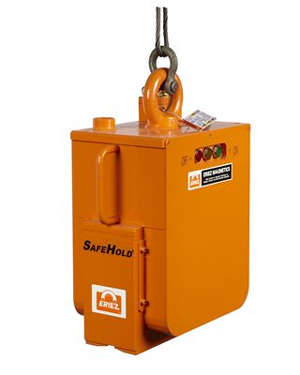By Peter C. Dent, VP Business Development • Electron Energy Corp.
What are the challenges, choices and solutions for the development and production of rare earth permanent magnets?
Rare earths have garnered much attention recently as the public becomes aware of the supply-chain issues stemming from China’s dominance of the production these 17 elements. Despite their name, the rare earths are not rare and have abundance in the earth’s crust comparable to tin and antimony. More than 300 deposits around the world are being discussed for potential commercialization. Just because a shovel full of dirt in many parts of the world indicates rare earths are present, however, does not necessarily mean that economic exploitation and commercial production can occur.Today more than 95 percent of rare earth oxides come from China. Data from 2010 indicates that 129,000 metric tonnes of rare earth elements were produced worldwide, with a small non-Chinese contribution. Over the past decade China’s dominance in this market has led to a near monopoly in raw materials and has resulted in a steep decline in US and non-Chinese rare earth and magnet production capabilities.
So with all this fear and uncertainty surrounding rare earths, why don’t we just avoid their use in new design applications? First, although substantial challenges exist over the next couple of years, new supply operations outside China are being aggressively developed, and governments and investors worldwide are working to fill in non-Chinese supply-chain gaps that can be sustainable over the long term. Second, Mother Nature has blessed these elements of the periodic table with unique characteristics that can produce much higher magnetic fields than anything else discovered so far.
Magnet Technology Overview
Up through the 1960s most permanent magnets were based on iron in combination with other transition metals such as cobalt and nickel. To this day, based on tonnage, the dominant magnet material by a very wide margin is ferrite, which is essentially a form of iron oxide. Non-rare earth magnets have been available for decades in the form of ferrites and aluminium nickel cobalt (alnico).

In the 1960s, researchers at Wright Patterson Air Force base discovered a new class of magnets based on the rare earth metal samarium and the transition metal cobalt. Rare earth magnets were born. In the 1980s, neodymium iron boron, another rare earth-transition metal magnet, was developed in Japan and the US. Rare earth magnets owe their superior properties, high induction and coercive force, to the unique combination of elements with unfilled ‘d’ and ‘f’ orbitals, in other words transition metals and rare earths. The combination of these elements and others allows the electrons in the alloy structure to align with one another anisotropically and obtain much higher residual induction, with a much higher resistance to being demagnetized, or intrinsic coercivity, than previous material systems.
A chart showing the relative strengths as measured by maximum energy product and maximum continuous operating temperature is shown in Figure 1. One can see the trend over time in the development of higher energy product magnets, which has been transferred into commercial acceptance as well. Around the year 2000, rare earth magnets eclipsed non-rare earth magnets in dollar volume of sales worldwide, even though they can be five to 20 or more times more expensive per kilogram than non-rare earth alternatives. The primary reason for this shift is due to higher magnetic flux per unit mass. This not only reduces magnet sizes but also reduces system costs by making surrounding components smaller. This helps to miniaturize the devices and therefore expand uses and broaden market penetration.
Future Permanent Magnetic Materials for Motors & Generators
For at least the next 10 years rare earth magnets will continue to be the material of choice for hybrid electric vehicle (HEV) internal permanent magnet (IPM) motor and generator designs as well as for higher speed, more compact brushless DC (BLDC) motor applications. Alternatively, synchronous electrical machines also serve an important role in motor and generator applications for a broad array of applications including HEVs where challenges occur in generating the low-speed torques required, especially at lower ambient temperatures.
Due to rare earth supply chain issues, some customers are currently re-designing and qualifying systems by replacement of higher dysprosium Nd-Fe-B magnets with samarium cobalt magnets whose properties in some cases can be very similar or even exceed performance of the original material. In addition, ferrite and alnico magnets can offer customers choices, however the gap between their performance and Nd-Fe-B is higher.
EEC is developing magnet technologies that will offer new classes of rare earth permanent magnets with high electrical resistivity. Fully dense sintered rare earth magnets are brittle intermetallics that have inherently low electrical resistivity. EEC’s novel approach comprises combining hard magnetic and ceramic phases, which will disrupt or reduce the flow of electrons through the bulk magnet material. This technology includes innovative processes, materials structures and compositions for the synthesis of higher electrical resistivity permanent magnets that can reduce eddy current losses in motors and generators.
If successfully developed commercially, these magnets with higher electrical resistivity will enhance electrical efficiency in higher speed motor and generator applications and help enable lower temperature operation, increase power density, increase pole counts, reduce cost and mitigate use of heavy rare earth elements. The proposed technology should lead to rare earth permanent magnets with electrical resistivity over 1,000 percent greater than current state-of-the-art rare earth magnets, while offering magnetic properties similar to current offerings.
For Much Higher Energy Product Magnets
Also shown in Figure 1 is a green bubble, representing the potential performance of the next generation of magnet materials currently being developed. These meta-materials are nanocomposite magnets that take ‘hard’ magnetic particles of NdFeB or SmCo on the nano scale and combine them with soft magnetic materials (iron). When the hard and soft magnetic phases are combined they act as one system. The key physical principle is that there is an exchange coupling between the soft phase and the hard magnetic phase. Nanocomposite magnets take the advantage of the high saturation magnetization of the soft magnetic phase and benefit from the high intrinsic coercivity of hard magnetic phase.

Development of these anisotropic high-energy permanent magnets are focused in the areas of nano particle production and developing approaches that will allow the interaction of the hard and soft phases to consistently achieve high induction and coercivity. In addition, consolidation techniques that are employed for rare earth magnets, such as sintering at high temperatures, will not work for these new systems due to adverse grain growth. Lower temperature processes such as die upsetting and hot pressing or others need to be developed for these new materials. Nanocomposites could reduce rare earth usage in two fundamental ways. First, the performance is enhanced since the total mass of the magnet to obtain a desired magnetic flux would be reduced substantially. In addition, the rare earth content will be diluted due to the addition of iron in amounts which could be as much as 30 percent.
Other rare earth-based magnet systems such as samarium iron nitride have been and are still topics of intense investigation. In fact, in the last century, a wide variety of systems have been thoroughly investigated. Although there are some magnetic structures that could theoretically be developed into magnets more powerful than current rare earth types, there are enormous fundamental challenges that would need to be overcome, making this a very risky research endeavor.
Application Example – High Temperature Hybrid Radial Magnetic Bearing System

Magnetic bearing technology is considered to be an enabling technology for new advanced engine designs. Rolling element bearings and squeeze dampers are currently used to support gas turbine engine rotors. These types of bearings are limited in temperature (<260°C) and speed and require both air cooling and a lubrication system. Innovative technologies, including high-temperature magnetic bearing technology, are necessary for the design and development of advanced space vehicles and power systems.
A novel high-temperature hybrid radial magnetic bearing capable of operating at 538°C (1,000°F) was developed by EEC in collaboration with Texas A&M University under a NASA Glenn Research Center SBIR Phase II contract (number NNC06CA04C). High temperature permanent magnets are used to carry the majority of the static rotor weight, instead of a magnetic bearing coil or electromagnets, which are used only for control. The permanent magnet bias of the radial magnetic bearing reduces the current required for magnetic bearing operation. This reduces the power loss due to the coil current resistance and increases system efficiency because high temperature permanent magnets are used to carry the majority of the static load on the bearing.
A novel feature of this high temperature magnetic bearing is its homopolar construction, which incorporates ultra-high-temperature SmCo-UHT permanent magnets. A second feature is its fault tolerance, which provides the desired control forces even with over half of the coils failed. The combined magnetic circuit of the hybrid magnetic bearing was designed via iterative 3D finite-element based electromagnetic field simulation. Figure 2 shows the FEA solid model. The bearing was designed to produce 2,225N of force at 538ºC and is driven by a 25,000 rpm 5.1 kW permanent magnet motor operating in the same environment with 0.45 T flux in the 0.1 cm air gap. (Figures 3 and 4.)

Although there are substantial issues with respect to China’s current dominance of rare earth elements, there are tremendous opportunities for technology development and commercial success. Rare earths in the short to long term will continue to be the materials of choice for many growing applications for which replacements will be very challenging if not impractical. This is a great area of business and technology to participate in through the balance of this decade.
 About the Author
About the Author
Peter C. Dent is the vice president of Business Development for Electron Energy Corp. Since joining EEC in 2003, Dent has led the company’s business development efforts in rare earth magnets and their applications, including commercialization and applications development of government sponsored research. Peter can be reached at pcd@electronenergy.com.



